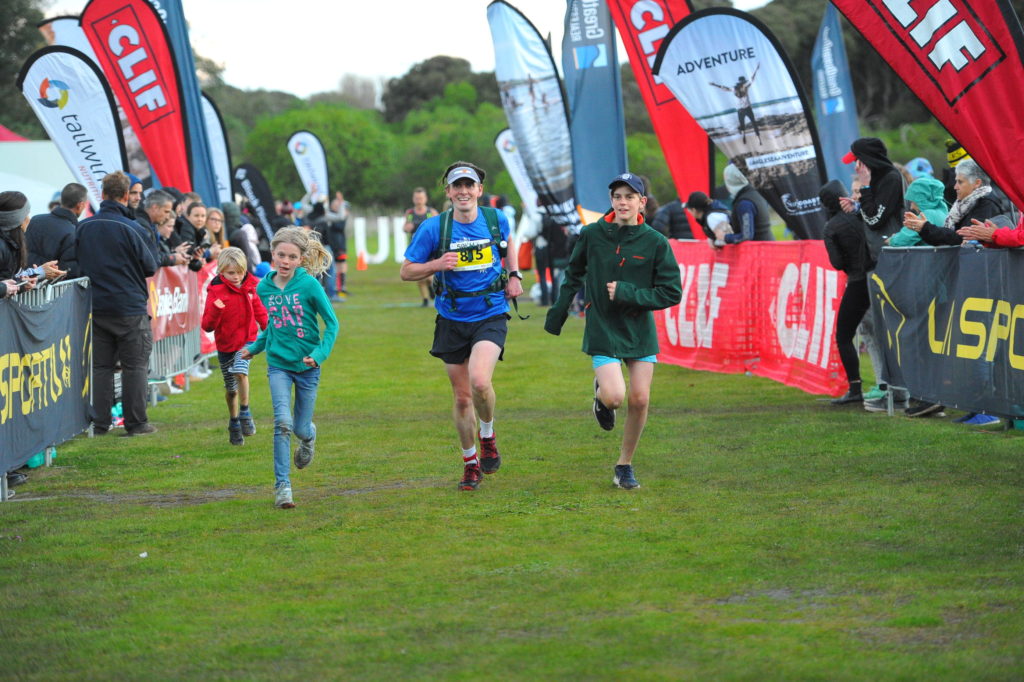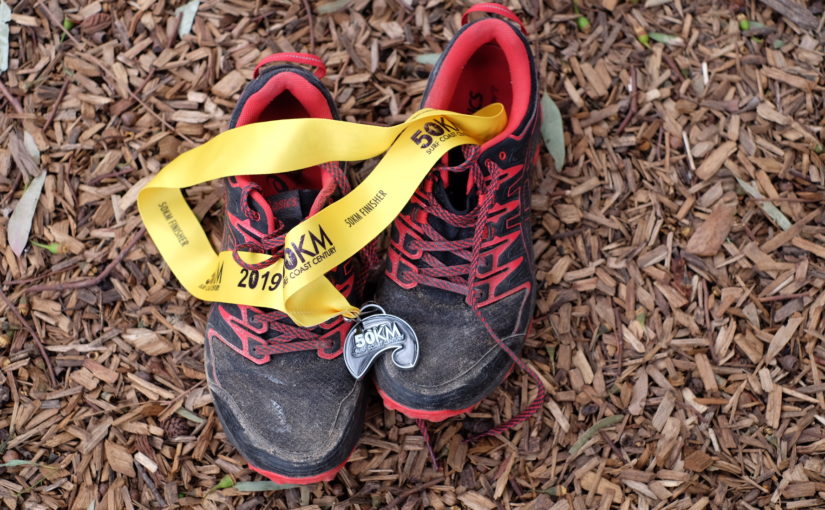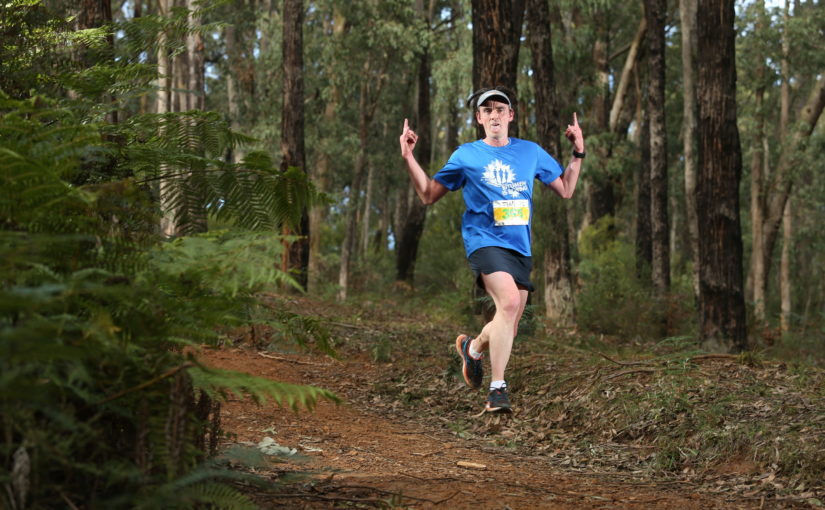Trying to explain why you’re running a 50km trail race is a bit like to trying to explain a dream you had last night; it all made sense in your own head, but now that you’re saying it out loud it sounds illogical and bizarre…and people are asking you to stop talking. But let me take you through the experience anyway.

After running the Melbourne Marathon last year, I knew that I trained a lot better if I was working towards something, but I had no desire to do Melbourne again, and I had really enjoyed doing the Rapid Ascent Trail Running Series in training, and so I started to think about doing the 50km version of the Surf Coast Century (the full race is 100kms).
It’s here that the logic starts to get a bit sketchy. I thought that seeing as I finished the marathon well, then adding an extra 8kms shouldn’t be too hard. *wrong* Plus I like running up hills, so the 1,136m of elevation gain could work in my favour *wronger* And I’ll be running in beautiful, natural environments that will distract me and keep my mind off how hard the running is *wrongest*.
With common-sense dispatched, I engaged Amanda as my coach again and got back into training. I ran the Rapid Ascent Trail series again, with some results better than last year, and some not as good. I gave myself one of the worst Father’s Day presents ever, a 38km training run, and I managed to get down to Anglesea for one of the training runs where they let you do a recce of the legs of the run (there are 4 legs for the 100km race, and the 50km race is the 3rd and 4th legs). So I arrived at the race feeling as prepared as I could be.

One of the weird things about doing the 50km version of this race instead of the 100km version is that while normally anyone running more than 40kms is treated like royalty and feted as a hero…at this event there are people quite literally running twice as far as you. So it can be a bit demoralising to know that you’re about to run the furthest you’ve ever run…but that you’re only really at best half as impressive as the people who are running the 100kms. On the bright side, at least you’re not doing it as a team…they’re only running 25kms, and really, who gets out of bed to run less than 30kms?!!!
The upside to doing the 50km version is that while the 100km runners start at about 7.30am, you don’t start until 11.50am. Which means you don’t have the same nerves about getting to sleep the night before, and you can wake up, have breakfast, have a coffee, go to the toilet, have another breakfast, and have another coffee before you even start the race!
The first leg is 28kms from Anglesea to Moggs Creek. It features the biggest hills of the day, and if it’s wet, some of the trails turn to a red mud that attaches itself to your shoes. But it also has a lot of beautiful tracks through the bush, and having done one training day on this section, I was really happy with how I paced myself through it. At about the 25km mark I got passed by a woman doing the 100km race. I told her that she was ‘smashing the 100’ and she said I was ‘smashing the 50!’ She went on to win the women’s race in just over 10hrs, and I would do half that distance in nearly 6.5 hours.
So one of us was lying.

Going into the race my goals were:
1. Finish
2. Finish without walking up any of the hills
3. Finish within 6hrs.
By the 28km checkpoint at Moggs Creek, I was feeling very strong about finishing. I had resorted to walking up the final hill before the checkpoint, but was bang on target to make it under 6hrs. So I celebrated by having a cup of Coke, banana, sandwich and some electrolytes (I know how to party). Then pulled out of the checkpoint and on to Airey’s Inlet where I was going to meet Katie and the kids. It’s only about 10kms, and I had given myself 1hr to get there, but this where the wheels started to fall off the cart. I started playing a game called yo-yo tiggy, which is a game where I pass people going up the hills and they pass me going down them. It’s a fun game, that absolutely no one wins. Then I started to have to walk up more of the hills. Then I started to feel really average. My legs felt hollow, and I just didn’t feel like I had any power. People I had passed previously started to come past me, and I was not in a happy place when I pulled into the aid station at Airey’s Inlet.

So it was awesome to see Katie and the kids, and even better to get them to refill my drink bottles and get me my food. I had 14kms to do in just over 90 minutes to break 6hrs, and I hoped that my improved mindset and fuel in my system would get me there.
But within 1km I knew something was wrong. My heart rate was over 180bpms and not dropping in the easier sections. I listen to a lot of podcasts when I’m training and a recent one had featured an interview with a triathlete who had raced all his life, and then in one race just felt terrible. He pushed on through, and then had a heart-attack afterwards. I had visions of one my kids delivering my eulogy saying ‘We really miss Dad, and wish he was still with us. But we totally understand and respect his decision to chase his arbitrary goal of 6hrs…a goal that no one else knew, let alone cared about.’ So I went back to my training I did 6 years ago when I started training for the Ironman, and ran until my heart-rate got beyond where I wanted it, then walked until it go back under control, and ran again, and then walked when it go too high. At one stage a guy in his 60’s jogged past me, and I remembered passing him just out of Mogg’s Creek, and that hurt. But I stuck to it, and eventually the periods of running got longer, and the walking shorter until I found a pace I could sustain without getting my heart-rate too high. My dreams of finishing in 6hrs were gone, but I was back on track and moving.

Then we hit Urquhart Bluff, which is about 5kms of running on the beach. For anyone hoping for a little respite from the tired legs and heavy feet of a long run, 5kms of running on soft sand is a real kick in the nads. But my decision to run in a way that would allow me to see my family again paid immediate dividends, when I saw my family again! They had been driving along the Great Ocean Road towards the finish line when they decided to stop at the beach. Then they started recognising other runners that they had seen at the Airey’s Inlet aid station when they were waitng for me and knew I mustn’t be too far away. So they ran with me for about 500ms and kept me company. I always say that the thought that people may come out to say hello at marathon or long-distance event is always a great distraction and motivation…but to have them actually turn up is even better!!!


As I neared the end of the beach and could see the stairs leading up and away, I thought back to the race profile and how there was a climb just before the finish. The guy I was running with had done the race before and so I asked if this was the final climb and he said ‘yes’. So I excitedly jogged up them and then ran along a long road that I knew would lead me to the beach at Anglesea and the finish line! I was suddenly full of relief. The hard yards had been done, and while I wasn’t going to get my goal time, at least I would finish strong.
The further along the road I went, the more I started to wonder how the beach we were going to run along, wound around the cliff face I could see rising to my left. Then with a sinking feeling I realised that the set of stairs wasn’t the last climb…getting over that sodding cliff was the last climb! And so it was. I got over the last hill and ran down the other side. I hit the beach and trudged through the sand and then finally onto the boardwalk. I cursed whoever designed the boardwalk for the two sections where I thought I was going to turn a corner to reveal the finish line, only to discover more boardwalk, then I turned off the boardwalk onto a section of trail that was probably on 100m long, but may as well as have been 5kms for how long it looked to someone who may have started their sprint for home a little too early, and then suddenly there was Katie and the kids and then there was the finish chute, and then there was the finish line…and then it was done. My first ever ultra-marathon done and dusted.



A massive thanks to my support crew (Katie, Josh, Holly and Xavier) for all their help on the day and for tolerating my absences during training, to Amanda for getting me to the line injury free and in a great mental space, and to Rapid Ascent and all of the volunteers for making it such an incredible day.

I would love to leave you with an inspirational quote about how I’m going to use the 50km run as springboard towards doing the 100km run next year, but as we were driving back through the dark of evening to our accomodation in Lorne, we could see light flickering in the hills behind Airey’s Inlet and I realised that these were the head-torches of people who were still at least 5kms from reaching the aid station and about 20kms away from finishing and I thought ‘Thank God I didn’t do the 100km!’





